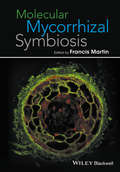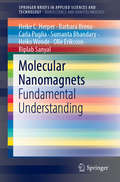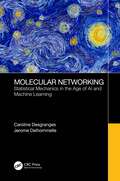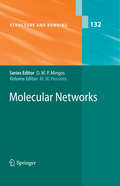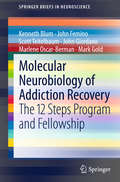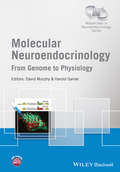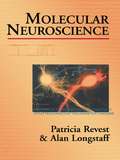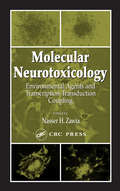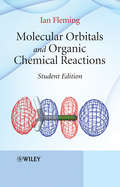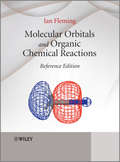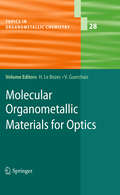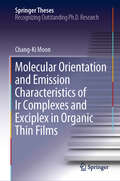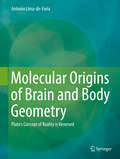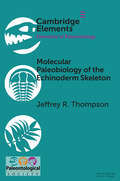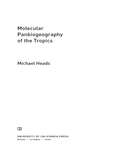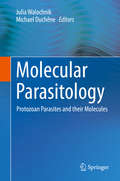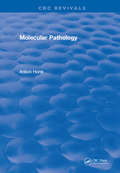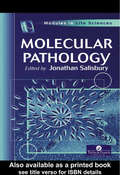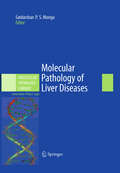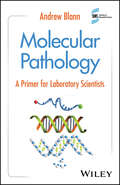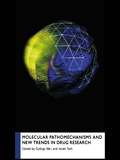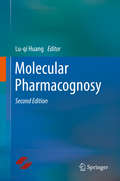- Table View
- List View
Molecular Mycorrhizal Symbiosis
by Francis MartinRecent years have seen extensive research in the molecular underpinnings of symbiotic plant-fungal interactions. Molecular Mycorrhizal Symbiosis is a timely collection of work that will bridge the gap between molecular biology, fungal genomics, and ecology. A more profound understanding of mycorrhizal symbiosis will have broad-ranging impacts on the fields of plant biology, mycology, crop science, and ecology. Molecular Mycorrhizal Symbiosis will open with introductory chapters on the biology, structure and phylogeny of the major types of mycorrhizal symbioses. Chapters then review different molecular mechanisms driving the development and functioning of mycorrhizal systems and molecular analysis of mycorrhizal populations and communities. The book closes with chapters that provide an overall synthesis of field and provide perspectives for future research. Authoritative and timely, Molecular Mycorrhizal Symbiosis, will be an essential reference from those working in plant and fungal biology.
Molecular Nanographenes: Synthesis, Properties, and Applications
by Nazario Martín Colin P. NuckollsExplore the world’s most powerful materials with nanographene research Graphene, comprised of a single layer of carbon atoms in a honeycomb nanostructural arrangement, is the thinnest and strongest material yet known to science. Despite that this pristine carbon allotrope exhibits a variety of outstanding properties, its zero bandgap prevents its use for some optoelectronic applications. Fragments of graphene, or nanographenes, have shown a great potential to obviate these problems, thus paving the way for the development of chiroptical and optoelectronic properties. Molecular Nanographenes constitutes a comprehensive overview on the synthesis of these materials and their properties. Covering their widely varying morphologies, their potential applications, and their valuable chiroptical and photophysical features, it also analyzes multiple approaches to obtain nanographene by using both top-down and bottom-up methodologies. The result is a one-stop shop for materials scientists and other researchers interested in these emergent and fascinating materials. Molecular Nanographenes readers will also find: A careful distinction between top-down and bottom-up approaches to nanographene synthesisDetailed discussion of nanographene configurations including planar, bilayer, helical, nanobelt, and many other geometries An authorial team with pioneering research experience in the study of nano-sized graphenes and their synthesis Molecular Nanographenes is ideal for materials scientists, polymer chemists, solid state chemists, organic chemists, and any other researchers looking to work with shape and size-controlled flakes of graphenes.
Molecular Nanomagnets: Fundamental Understanding (SpringerBriefs in Applied Sciences and Technology)
by Heike C. Herper Barbara Brena Carla Puglia Sumanta Bhandary Heiko Wende Olle Eriksson Biplab SanyalThis book focuses on 3d transition metal centered phthalocyanine molecules and their deposition on different substrates. Phthalocyanines are an ideal prototype since they can be grown flat on many surfaces. It highlights the molecule-substrate interaction and its influence on the magnetic and spectroscopic properties of the molecules as well as the influence of ligands — reviewing both experiential and theoretical data. Since experimental setups differ and approximations in theory vary and can influence the result, a substantial part is dedicated to a thorough discussion of the different experimental and computational methods from the point of view of reliability and predictive power.
Molecular Networking: Statistical Mechanics in the Age of AI and Machine Learning
by Caroline Desgranges Jerome DelhommelleThe book builds on the analogy between social groups and assemblies of molecules to introduce the concepts of statistical mechanics, machine learning and data science. Applying a data analytics approach to molecular systems, we show how individual (molecular) features and interactions between molecules, or "communication" processes, allow for the prediction of properties and collective behavior of molecular systems - just as polling and social networking shed light on the behavior of social groups. Applications to systems at the cutting-edge of research for biological, environmental, and energy applications are also presented.Key features: Draws on a data analytics approach of molecular systems Covers hot topics such as artificial intelligence and machine learning of molecular trends Contains applications to systems at the cutting-edge of research for biological, environmental and energy applications Discusses molecular simulation and links with other important, emerging techniques and trends in computational sciences and society Authors have a well-established track record and reputation in the field
Molecular Networks
by Mir Wais HosseiniFrom the reviews: “This book gives an overview of some recent developments in crystal engineering of molecular and metalloorganic solids in five, essentially independent chapters written by different authors. … All in all, this book makes good reading material that can appeal to nonexperts by showcasing some recent developments in the field of crystal engineering, as well as to … experts seeking a detailed overview of a specific subfield, such as a comprehensive account of all possible assemblies of bipyridine-dioxide … .” (Dmitrii F. Perepichka, Journal of the American Chemical Society, Vol. 132 (11), 2010)
Molecular Neurobiology of Addiction Recovery
by Kenneth Blum Marlene Oscar-Berman John Femino John Giordano Mark Gold Scott TeitelbaumHumans are biologically programmed to seek out pleasurable experiences. These experiences are processed in the mesolimbic system, also referred to as the "reward center" of the brain, where a number of chemical messengers work in concert to provide a net release of dopamine in the Nucleus Accumbens. In some genetically predisposed individuals, addiction occurs when the mechanisms of the mesolimbic system are disrupted by the use of various drugs of abuse. Since Alcoholics Anonymous was founded in 1935, it's 12 step program of spiritual and character development has helped countless alcoholics and drug addicts curb their self-destructive behaviors. However, the program was developed at a time when comparatively little was known about the function of the brain and it has never been studied scientifically. This is the first book to take a systematic look at the molecular neurobiology associated with each of the 12 steps and to review the significant body of addiction research literature that is pertinent to the program.
Molecular Neuroendocrinololgy
by David Murphy Harold GainerMolecular Neuroendocrinology: From Genome to Physiology, provides researchers and students with a critical examination of the steps being taken to decipher genome complexity in the context of the expression, regulation and physiological functions of genes in neuroendocrine systems. The 19 chapters are divided into four sectors: A) describes and explores the genome, its evolution, expression and the mechanisms that contribute to protein, and hence biological, diversity. B) discusses the mechanisms that enhance peptide and protein diversity beyond what is encoded in the genome through post-translational modification. C) considers the molecular tools that today's neuroendocrinologists can use to study the regulation and function of neuroendocrine genes within the context of the intact organism. D) presents a range of case studies that exemplify the state-of-the-art application of genomic technologies in physiological and behavioural experiments that seek to better understand complex biological processes. * Written by a team of internationally renowned researchers* Both print and enhanced e-book versions are available* Illustrated in full colour throughout This is the third volume in a new Series 'Masterclass in Neuroendocrinology' , a co- publication between Wiley and the INF (International Neuroendocrine Federation) that aims to illustrate highest standards and encourage the use of the latest technologies in basic and clinical research and hopes to provide inspiration for further exploration into the exciting field of neuroendocrinology. Series Editors: John A. Russell, University of Edinburgh, UK and William E. Armstrong, The University of Tennessee, USA
Molecular Neuroscience
by Alan Longstaff Dr P RevestThis book provides insights into general experimental strategies and quite detailed accounts of experiments in molecular neuroscience. It is useful to final year undergraduates and post-graduates interested in the impact that the new science of molecular biology is having on neuroscience.
Molecular Neurotoxicology: Environmental Agents and Transcription-Transduction Coupling
by Nasser H. ZawiaMolecular Neurotoxicology: Environmental Agents and Transcription-Transduction Coupling deals with changes in gene expression following exposure to neurotoxicants, as well as deciphering signal transduction or transcription coupling that is altered by the same exposure. Until now, little has been published on the topic in one reference, and toxicol
Molecular Oncology
by Edward P. Gelmann Charles L. Sawyers Frank J. Rauscher III Edward P. Gelmann Charles L. SawyersThe genomic era has allowed enormous strides in our understanding of the molecular changes that underlie malignant transformation. Mutations have been discovered that are critical drivers of large cross-sections of human cancers. These discoveries have allowed us to find drugs that target these drivers and make important strides in treatment. Genomics and high-throughput technologies have illuminated the complexity of cancer and the facility with which cancers adapt during their natural history. The field is evolving rapidly with new discoveries and new drugs reported monthly. This book is a timely foundation for understanding in context the origins of molecular oncology and its future directions. The content reviews available technologies for the analysis of cancer tissues and genes; summaries of key oncogenic pathways from a molecular perspective; the technologies, pathways and targeted therapies of a wide range of human malignancies; and new pharmacologic therapies that have a common mechanistic target.
Molecular Orbitals and Organic Chemical Reactions
by Ian FlemingWinner of the PROSE Award for Chemistry & Physics 2010Acknowledging the very best in professional and scholarly publishing, the annual PROSE Awards recognise publishers' and authors' commitment to pioneering works of research and for contributing to the conception, production, and design of landmark works in their fields. Judged by peer publishers, librarians, and medical professionals, Wiley are pleased to congratulate Professor Ian Fleming, winner of the PROSE Award in Chemistry and Physics for Molecular Orbitals and Organic Chemical Reactions.Molecular orbital theory is used by chemists to describe the arrangement of electrons in chemical structures. It is also a theory capable of giving some insight into the forces involved in the making and breaking of chemical bonds--the chemical reactions that are often the focus of an organic chemist's interest. Organic chemists with a serious interest in understanding and explaining their work usually express their ideas in molecular orbital terms, so much so that it is now an essential component of every organic chemist's skills to have some acquaintance with molecular orbital theory.Molecular Orbitals and Organic Chemical Reactions is both a simplified account of molecular orbital theory and a review of its applications in organic chemistry; it provides a basic introduction to the subject and a wealth of illustrative examples. In this book molecular orbital theory is presented in a much simplified, and entirely non-mathematical language, accessible to every organic chemist, whether student or research worker, whether mathematically competent or not. Topics covered include:Molecular Orbital Theory Molecular Orbitals and the Structures of Organic Molecules Chemical Reactions -- How Far and How Fast Ionic Reactions -- Reactivity Ionic Reactions -- Stereochemistry Pericyclic Reactions Radical Reactions Photochemical Reactions Slides for lectures and presentations are available on the supplementary website: www.wiley.com/go/fleming_studentMolecular Orbitals and Organic Chemical Reactions: Student Edition is an invaluable first textbook on this important subject for students of organic, physical organic and computational chemistry.The Reference Edition edition takes the content and the same non-mathematical approach of the Student Edition, and adds extensive extra subject coverage, detail and over 1500 references. The additional material adds a deeper understanding of the models used, and includes a broader range of applications and case studies. Providing a complete in-depth reference for a more advanced audience, this edition will find a place on the bookshelves of researchers and advanced students of organic, physical organic and computational chemistry. Further information can be viewed here."These books are the result of years of work, which began as an attempt to write a second edition of my 1976 book Frontier Orbitals and Organic Chemical Reactions. I wanted to give a rather more thorough introduction to molecular orbitals, while maintaining my focus on the organic chemist who did not want a mathematical account, but still wanted to understand organic chemistry at a physical level. I'm delighted to win this prize, and hope a new generation of chemists will benefit from these books."-Professor Ian Fleming
Molecular Orbitals and Organic Chemical Reactions
by Ian FlemingWinner of the PROSE Award for Chemistry & Physics 2010Acknowledging the very best in professional and scholarly publishing, the annual PROSE Awards recognise publishers' and authors' commitment to pioneering works of research and for contributing to the conception, production, and design of landmark works in their fields. Judged by peer publishers, librarians, and medical professionals, Wiley are pleased to congratulate Professor Ian Fleming, winner of the PROSE Award in Chemistry and Physics for Molecular Orbitals and Organic Chemical Reactions.Molecular orbital theory is used by chemists to describe the arrangement of electrons in chemical structures. It is also a theory capable of giving some insight into the forces involved in the making and breaking of chemical bonds--the chemical reactions that are often the focus of an organic chemist's interest. Organic chemists with a serious interest in understanding and explaining their work usually express their ideas in molecular orbital terms, so much so that it is now an essential component of every organic chemist's skills to have some acquaintance with molecular orbital theory.Molecular Orbitals and Organic Chemical Reactions is both a simplified account of molecular orbital theory and a review of its applications in organic chemistry; it provides a basic introduction to the subject and a wealth of illustrative examples. In this book molecular orbital theory is presented in a much simplified, and entirely non-mathematical language, accessible to every organic chemist, whether student or research worker, whether mathematically competent or not. Topics covered include:Molecular Orbital TheoryMolecular Orbitals and the Structures of Organic MoleculesChemical Reactions -- How Far and How FastIonic Reactions -- ReactivityIonic Reactions -- StereochemistryPericyclic ReactionsRadical ReactionsPhotochemical ReactionsThis expanded Reference Edition of Molecular Orbitals and Organic Chemical Reactions takes the content and the same non-mathematical approach of the Student Edition, and adds extensive extra subject coverage, detail and over 1500 references. The additional material adds a deeper understanding of the models used, and includes a broader range of applications and case studies. Providing a complete in-depth reference for a more advanced audience, this edition will find a place on the bookshelves of researchers and advanced students of organic, physical organic and computational chemistry.The student edition of Molecular Orbitals and Organic Chemical Reactions presents molecular orbital theory in a simplified form, and offers an invaluable first textbook on this important subject for students of organic, physical organic and computational chemistry. Further information can be viewed here."These books are the result of years of work, which began as an attempt to write a second edition of my 1976 book Frontier Orbitals and Organic Chemical Reactions. I wanted to give a rather more thorough introduction to molecular orbitals, while maintaining my focus on the organic chemist who did not want a mathematical account, but still wanted to understand organic chemistry at a physical level. I'm delighted to win this prize, and hope a new generation of chemists will benefit from these books."-Professor Ian Fleming
Molecular Organometallic Materials for Optics
by Véronique Guerchais Hubert BozecS. Di Bella, C. Dragonetti, M. Pizzotti, D. Roberto, F. Tessore, R. Ugo: Coordination and Organometallic Complexes as Second-Order Nonlinear Optical Molecular Materials.- M. G. Humphrey, M.P. Cifuentes, M. Samoc: NLO Molecules and Materials Based on Organometallics: Cubic NLO Properties.- L. Murphy, J. A. G. Williams: Luminescent Platinum Compounds: From Molecules to OLEDs. - Z. Liu, Z. Bian, C. Huang: Luminescent Iridium Complexes and Their Applications.- N. C. Fletcher, M. C. Lagunas: Chromo- and Fluorogenic Organometallic Sensors.- V. Guerchais, H. Le Bozec: Metal Complexes Featuring Photochromic Ligands.
Molecular Orientation and Emission Characteristics of Ir Complexes and Exciplex in Organic Thin Films (Springer Theses)
by Chang-Ki MoonThis thesis considers molecular orientation in thin films and introduces an optical model describing this orientation as applied to organic light-emitting diodes (OLEDs). It also describes the electronic structure of intermolecular charge transfer excitons correlated to molecular orientation in solids.It has long been known that molecular orientation influences the electrical and optical properties of molecular films. One notable example is in liquid crystals where rigid rod or disk shaped molecules are commonly used. Understanding the origin of the molecular orientation and its control by surface treatment and electric field resulted in the development of liquid crystal displays. The same thing has happened in organic electronics, and considerable effort has been devoted to understanding and controlling molecular orientation in solid films to improve charge carrier mobility and light absorption, ultimately to improve the performance of organic solar cells and thin film transistors.In contrast, less attention has been paid to molecular orientation and its influence on the characteristics of OLEDs, probably because of the use of amorphous films rather than micro-crystalline films, and it is only in recent years that some molecular films are known to have preferred orientation. This thesis addresses this topic, focusing on OLEDs, describing the origin and control of the orientation of phosphorescent Ir complexes possessing spherical shape rather than rod or disk shape, the simulation of the optical characteristics of OLEDs influenced by preferred molecular orientation, and finally the orientation of intermolecular charge transfer excitons and its correlation to electronic structures in thin films.
Molecular Origins of Brain and Body Geometry
by Antonio Lima-de-FariaNew concepts arise in science when apparently unrelated fields of knowledge are put together in a coherent way. The recent results in molecular biology allow to explain the emergence of body patterns in animals that before could not be understood by zoologists. There are no "fancy curiosities" in nature. Every pattern is a product of a molecular cascade originating in genes and a living organism arises from the collaboration of these genes with the outer physical environment. Tropical fishes are as startling in their colors and geometric circles as peacocks. Tortoises are covered with the most regular triangles, squares and concentric circles that can be green, brown or yellow. Parallel scarlet bands are placed side by side of black ones along the body of snakes. Zebras and giraffes have patterns which are lessons in geometry, with their transversal and longitudinal stripes, their circles and other geometric figures. Monkeys, like the mandrills, have a spectacularly colored face scarlet nose with blue parallel flanges and yellow beard. All this geometry turns out to be highly molecular. The genes are many and have been DNA sequenced. Besides they not only deal with the coloration of the body but with the development of the brain and the embryonic process. A precise scenario of molecular events unravels in the vertebrates. It may seem far-fetched, but the search for the origin of this geometry made it mandatory to study the evolution of matter and the origin of the brain. It turned out that matter from its onset is pervaded by geometry and that the brain is also a prisoner of this ordered construction. Moreover, the brain is capable of altering the body geometry and the geometry of the environment changes the brain. Nothing spectacular occurred when the brain arrived in evolution. Not only it came after the eye, which had already established itself long ago, but it had a modest origin. It started from sensory cells on the skin that later aggregated into clusters of neurons that formed ganglia. It also became evident that pigment cells, that decide the establishment of the body pattern, originate from the same cell population as neurons (the neural crest cells). This is a most revealing result because it throws light on the power that the brain has to rapidly redirect the coloration of the body and to change its pattern. Recent experiments demonstrate how the brain changes the body geometry at will and within seconds, an event that could be hardly conceived earlier. Moreover, this change is not accidental it is related to the surrounding environment and is also used as a mating strategy. Chameleons know how to do it as well as flat fishes and octopuses. No one would have dared to think that the brain had its own geometry. How could the external geometry of solids or other figures of our environment be apprehended by neurons if these had no architecture of their own? Astonishing was that the so called "simple cells", in the neurons of the primary visual cortex, responded to a bar of light with an axis of orientation that corresponded to the axis of the cell''s receptive field. We tend to consider our brain a reliable organ. But how reliable is it? From the beginning the brain is obliged to transform reality. Brain imagery involves: form, color, motion and sleep. Unintentionally these results led to unexpected philosophical implications. Plato''s pivotal concept that "forms" exist independently of the material world is reversed. Atoms have been considered to be imaginary for 2,000 years but at present they can be photographed, one by one, with electron microscopes. The reason why geometry has led the way in this inquiry is due to the fact that where there is geometry there is utter simplicity coupled to rigorous order that underlies the phenomenon where it is recognized. Order allows variation but imposes at the same time a canalization that is patent in what we call evolution.
Molecular Paleobiology of the Echinoderm Skeleton (Elements of Paleontology)
by Jeffrey R. ThompsonThe echinoderms are an ideal group to understand evolution from a holistic, interdisciplinary framework. The genetic regulatory networks underpinning development in echinoderms are some of the best known for any model group. Additionally, the echinoderms have an excellent fossil record, elucidating in in detail the evolutionary changes underpinning morphological evolution. In this Element, the echinoderms are discussed as a model group for molecular palaeobiological studies, integrating what is known of their development, genomes, and fossil record. Together, these insights shed light on the molecular and morphological evolution underpinning the vast biodiversity of echinoderms, and the animal kingdom more generally.
Molecular Panbiogeography of the Tropics
by Michael HeadsMolecular studies reveal highly ordered geographic patterns in plant and animal distributions. The tropics illustrate these patterns of community immobilism leading to allopatric differentiation, as well as other patterns of mobilism, range expansion, and overlap of taxa. Integrating Earth history and biogeography, Molecular Panbiogeography of the Tropics is an alternative view of distributional history in which groups are older than suggested by fossils and fossil-calibrated molecular clocks. The author discusses possible causes for the endemism of high-level taxa in tropical America and Madagascar, and overlapping clades in South America, Africa, and Asia. The book concludes with a critique of adaptation by selection, founded on biogeography and recent work in genetics.
Molecular Parasitology
by Julia Walochnik Michael DuchêneIn the past years, genome projects for numerous human parasites have been completed and now allow first in depth comparisons and evolutionary conclusions. The genomes of parasites reflect the coevolution with their host, metabolic capacities depending on their respective habitat in the host. Gut parasites usually have an anaerobic metabolism, while blood parasites have an aerobic metabolism, intracellular parasites escape the immune system, while extracellular parasites evade the immune system, usually by antigenic variation. Comprehensive genome data now being available allow us to address profound scientific questions, such as which traits enable the parasite to survive in the human host, which to cause disease and which can be used as drug targets. This book intends to give an overview of the state of knowledge on "the molecules" of protozoan parasites - on their genomes, proteomes, glycomes and lipidomes.
Molecular Pathology
by Antoni HorstThis book provides modern views of developments in medical sciences based on advances in molecular pathology. Topics discussed include the molecule; the genome of eukaryotes and its function; gene regulation; the proteins; molecular aspects of inflammation, immunology, and carcinogenesis; molecular biology of the nervous system; molecular defects in the endocrine system; molecular diseases of the blood and blood-forming tissues; and diagnosis of molecular diseases. Four tables and 75 figures illustrate the concepts and provide a quick means to reference important data. Immunologists, pathologists, geneticists, and all other researchers in the biological and medical sciences will find a wealth of information in this ground-breaking new book.
Molecular Pathology
by Jonathan R. SalisburyWritten by an acknowledged expert in the field, this book is an invaluable introductory guide for students studying chemistry, biochemistry and medicine. Provides a simple description of how aspects of molecular patholgy affect diseases.
Molecular Pathology of Liver Diseases
by Philip T. Cagle Satdarshan P. MongaCellular and Molecular Pathology of the Liver is extensive, complex and ranges from the understanding the basic molecular mechanisms that dictate everything from liver homeostasis to liver disease. Molecular Pathology of the liver is complicated due to some of the important functions inherent and unique to the Liver, including its innate ability to regenerate and the multitude of functions it plays for the wellbeing of an organism. With all this in mind, Molecular Pathology of Liver Diseases is organized in different sections, which will coherently and cohesively present the molecular basis of hepatic physiology and pathology. The first two sections are key to understanding the liver anatomy and physiology at a cellular level and go on to define the molecular mechanics in various liver cell types. These sections also cover the existing paradigms in liver development, regeneration and growth. The next section is key to understanding the Molecular Pathology unique to liver diseases and associated phenotypes. The final sections are geared towards the existing knowledge of the molecular basis of many common and uncommon liver diseases in both neoplastic and non-neoplastic areas including pathologies associated with intra-hepatic and extra-hepatic biliary tree. Thus, this textbook is a one-stop reference for comprehending the molecular mechanisms of hepatic pathobiology. It is clearly unique in its format, readability and information and thus will be an asset to many in the field of Pathology and other disciplines.
Molecular Pathology: A Primer for Laboratory Scientists
by Andrew BlannComprehensive textbook on molecular pathology for newcomers to the field, covering history, analytics, types of cancers, and more Molecular Pathology delivers an in-depth outline of molecular pathology appropriate for the undergraduate, postgraduate, or early-stage career lab scientist, drawing from authoritative sources such as NICE, the World Health Organisation, the Office of National Statistics, clinical guidelines, research publications and the National Genomic Test Directory. The text contains numerous tables, diagrams, and photos in each chapter to help elucidate key concepts. The opening chapter provides a general introduction to the subject with a historical perspective of key findings that have led to our current view of molecular pathology. The introduction is followed by a look at the scope of chromosomal disease (such as Down’s syndrome) and genetic disease (such as sickle cell disease). Chapter two describes the numerous analytical tools required in molecular pathology, and how complex genetic data is interpreted – i.e., bioinformatics. The remaining three chapters review the molecular pathology of focused groups of disease, including solid tumor cancer, blood cancer, and metabolic and other genetic diseases. Each of these three chapters explains the role of molecular pathology in the etiology, diagnosis, and management of each particular condition. Sample topics explored in Molecular Pathology include: Generating DNA and RNA for analysis, amplification by PCR, and DNA sequencing through micro-arrays, libraries, and Next Generation SequencingChromosome structure, covering histones and the centromere, abnormal chromosome numbers, and errors within chromosomes such as translocations and deletionsMyelofibrosis, myelodysplasia, essential thrombocythemia, polycythaemia, leukemia, lymphoma, myeloma, and haemopoiesis and maturation arrestMolecular pathology of single organ/organ system disease, such as Huntington’s and cardiomyopathy, and multi-organ disease such as Barth syndrome Molecular Pathology serves as an excellent introduction to the subject for first to third year undergraduate students. Healthcare professionals and biomedical scientists and researchers will also find it valuable.
Molecular Pathomechanisms and New Trends in Drug Research
by György Kéri István TothKnowledge of the basic mechanisms of human disease is essential for any student or professional engaged in drug research and development. Functional gene analysis (genomics), protein analysis (proteomics), and other molecular biological techniques have made it possible to understand these cellular processes, opening up exciting opportunities for no
Molecular Pharmacognosy
by Lu-Qi Huang"Molecular Pharmacognosy" discusses the application of molecular biology in resource science and authentication of traditional Chinese medicine (TCM). This book reviews the latest developments in pharmacognosy, introduces a series of new views and insights, presents the hotspots and focus of the field of study on molecular pharmacognosy, and predicts a new direction of study on the resource science of TCM. Furthermore, the book also provides an open communications platform for the development of molecular pharmacognosy. This book is intended for biomedical scientists and researchers in the fields of molecular biology, traditional medicine and natural pharmaceutics. Professor Lu-qi Huang is Director of the Collaborating Centre of the World Health Organization for Traditional Medicine (Chinese Materia Medica) and Vice-Chairman of the Australia Chinese Association for Biomedical Sciences Inc.
Molecular Pharmacognosy
by Lu-Qi HuangThis book discusses the application of molecular biology in resource science and authentication of traditional Chinese medicine (TCM). It also reviews the latest developments in pharmacognosy, introduces new perspectives and insights, discusses the hotspots and focuses in the field of molecular pharmacognosy, and predicts new directions of study. In the last five years, the technologies and scope of molecular pharmacognosy have constantly expanded and evolved. As such, this new edition includes extra content, such as the molecular phylogeography of medicinal plants, functional genome of medicinal plants, and synthetic biology of active compounds. Elucidating the concept, theory, and methodology of molecular pharmacognosy, it promotes the full use of the newly developed technologies and methodologies within the framework of molecular pharmacognosy to solve problems in the field.
